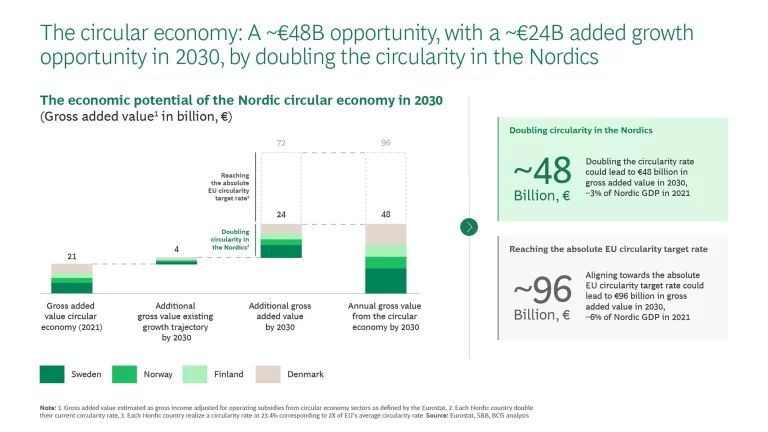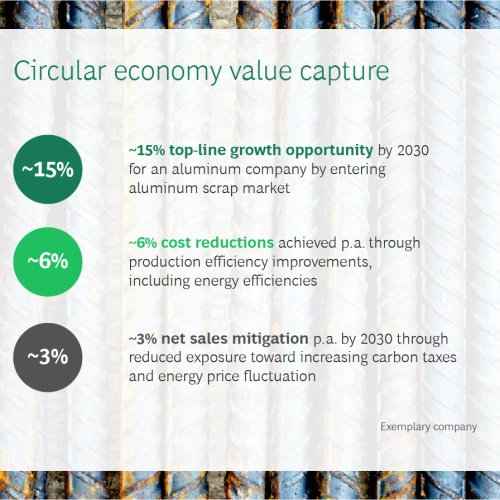Unlock Value Pools with a Circular Economy Mindset

Applying a Nordic circular economy mindset can help companies capture new top-line growth, achieve cost efficiencies, and mitigate supply chain and regulatory risks – all within the boundaries of our planet.
To stay within the safe operating space of our planet, we need to transition from a linear to a circular economy, where products are used and repaired for as long as possible and then deconstructed so that their constituent materials can be used to create new goods of similar value.
Today, 6% of the Nordic region’s economy is circular—meaning that ~6% of resources used for production come from recovered materials. By comparison, the EU average is at ~12% circularity, with an ambition to double the rate by 2030. Reaching this ambition in the Nordics could unlock an annual ~€48 billion economic opportunity by 2030, similar to 3% of the Nordic region’s GDP in 2021.
Many companies, however, struggle to implement circularity and move beyond isolated circular actions with little impact.
CIRCelligence by BCG provides a comprehensive holistic approach that enables businesses to integrate circularity into their core business strategy in a way that delivers economic benefits and also maximizes total societal value.

Five Key Nordic Sectors with Significant Circular Economy Value Capture
The adoption of a circular economy mindset can enable companies to capture significant value pools across industries. However, the nature, maturity, and scale of the value pools are industry specific and vary based on customer sentiment, regulation, technology, and level of competition for scarce resources.
In this section, a sample of specific circular economy trends and value pools are illustrated in five large Nordic sectors: packaging, consumer goods, machinery and industrial goods, metals and mining, and transportation.

Ensure alignment with mandatory reusability and recyclability targets to mitigate regulatory risks and avoid potential sales losses.
Embrace circular design principles, such as light weighting, to reduce material usage and achieve cost savings, including in freight expenses.

Incorporate circular principles: Embed recycled/sustainable materials, repair services, and circular design to products to differentiate, reduce costs, and attract new customers.
Optimize resource consumption and inventory management: Improve efficiency in water, energy, waste, and chemicals usage to save cost. Enhance inventory management to reduce overstock, waste, and cut costs.

Optimize cost with circular design and material recovery: Implement lightweighting and modular component design. Prioritize material reuse, repurposing, and remanufacturing.
Leverage customer touchpoints and data for innovation: Focus on continuous engagement, loyalty, and use product data for improvements and enhanced performance.

Explore integration and acquisitions: Acquire waste management companies for better access to recycled materials enhancing circularity and optimizing supply chains.
Drive cost efficiencies through material optimization: Use recycled materials, optimize energy consumption for cost savings and improve operational efficiency.

Explore EV battery recycling and reuse: Invest in EV battery recycling, repurpose used EV batteries and diversify revenue streams.
Mitigate risks and optimize supply chains: Adopt circular economy principles to mitigate disruptions, meet regulations, reduce dependence on volatile metal prices and supply imbalances.
A Pathway to Sustainable Growth and Competitive Advantage
Upcoming regulations at EU and Nordic levels will accelerate Nordic companies toward circularity by raising compliance thresholds and redirecting value pools toward circular economy solutions. This presents a valuable opportunity for companies to embrace circular practices and capitalize on the economic potential, while inaction may result in a loss of value.
In addition, the circular economy presents a powerful and unified approach to address multiple environmental challenges and provide companies with a competitive advantage. Adopting a circular economy mindset enables companies to decouple growth from adverse environmental impacts related to resource consumption, waste generation, pollution, water scarcity, land use change, and climate mitigation, providing both environmental and business benefits.










